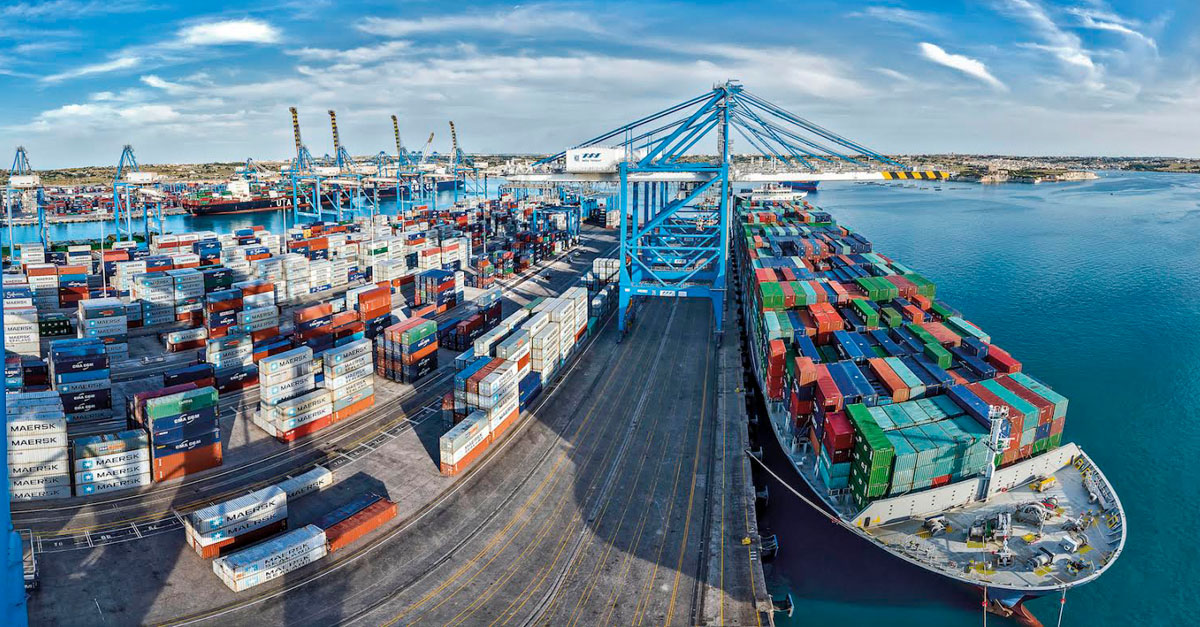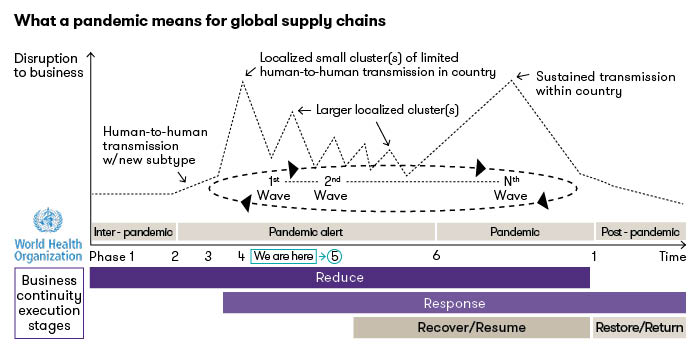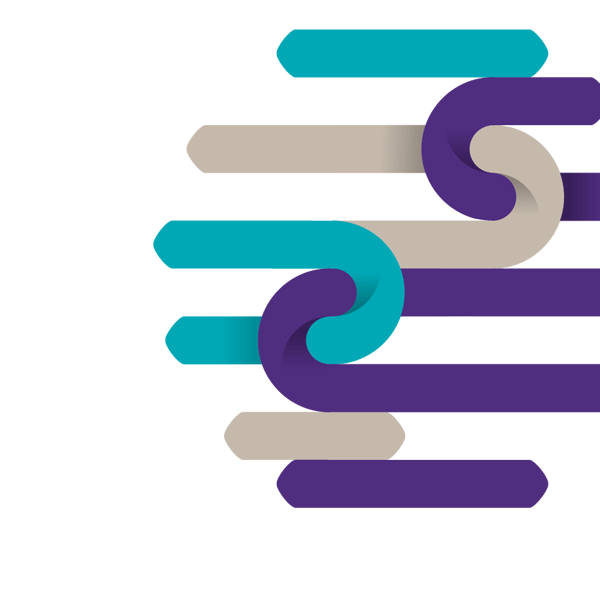
Article originally published on www.grantthornton.com
The COVID-19 pandemic is upending the carefully calibrated logistics of global shipping and highlighting long-standing concerns. Plunging exports from China and congestion at Chinese ports are disrupting the trade of American goods. US farm products destined for Asian markets are stuck at Chinese ports, creating a traffic jam that is driving up prices for US exporters and sowing additional turmoil on top of a not-yet-resolved trade war. Factory shutdowns have crippled China’s industrial production. As a result, shipping volumes out of China have fallen.
A record 2 million containers of ocean-going cargo stalled in February, per Alphaliner – a Paris based marine data provider. That February number is higher than the 1.5 million in cargo idled in 2009 during the height of the Great Recession. Delivery issues; rising concerns around product availability, cost, and quality; and decreased manufacturing capacity stemming from plant closures and workforce shortages are all disrupting supply chains. While the ultimate effects of the COVID-19 crisis can’t be known yet, there is no question COVID-19 threatens the supply chains of both small and large organizations around the globe.
In the March 4, 2020 edition of Grant Thornton’s Economic Currents, Grant Thornton Chief Economist Diane Swonk discussed how COVID-19, combined with business investment decline, corporate debt levels, and low unemployment figures, could drop global GDP into recession. COVID-19 is directly suppressing growth on a global scale at sufficient magnitude to drive down GDP forecasts. Declines in travel and consumer spending support that projection.
Organizations need to act now to improve supply chain resilience and mitigate evolving constraints and related financial performance issues. They must focus organizational resources on the most important value protection and cash management efforts and determine whether this is the time to implement their business continuity plans and crisis management teams. They need to define the immediate, critical resiliency responses required to boost corporate performance, viability and sustainability. Supply chain disruptions increase the likelihood of logistical, financial, and solvency concerns, especially in the absence of substantial working capital or ready access to credit. A lack of organizational resiliency presents an essential modern day challenge for today’s business leaders. Many organizations are not prepared for a pandemic event.

On March 11, 2020 the World Health Organization declared COVID-19 a full-blown global pandemic, with sustained transmission of COVID-19 within most, if not all, countries and widespread community transmission between individual persons. This will mean even greater business disruption and financial losses, along with rapid setbacks to global GDP forecasts. This pandemic may also cause sizeable workforce availability constraints, as employees stay home to protect themselves, care for family members or are placed under local health quarantine.
The COVID-19 crisis presents today’s business leaders with a challenge the global economy has not faced since the Spanish Flu pandemic, which occurred between 1918-20. The Spanish Flu infected up to one third of the world population, with a mortality rate of approximately 3%, killing many young adults in the prime of their lives. Over the subsequent 100 years, the growth engines driving business ecosystems have changed, becoming broadly global and dependent on trade across far-flung supply chains. These supply changes are finely tuned to manage raw material and production costs and to deliver competitively priced products to consumers. The time and cost variances of a pandemic shock would severely affect already fragile supply chains. Such a crisis heightens the need for organizations to be able to access, quantify and respond to supply chain risks in real time. Otherwise, supply chain disruptions increase the likelihood of logistical, financial and solvency concerns, especially in the absence of substantial working capital or ready access to credit. The lack of organizational resiliency in the face of a pandemic presents an essential challenge for today’s business leaders.
Following are eight supply chain lessons organizations can apply today to better understand, prepare for and combat the disruptions of the COVID-19 pandemic.
8 Lessons for Mitigating Supply Chain Disruptions
- Lesson 1: Build a supply chain risk management governance framework and link underlying processes and key risk triggers to a business continuity plan
- Governance framework should be documented with clear roles and responsibilities
- Scope and objectives and desired outputs should be clearly defined
- Resiliency planning and business continuity must be included and tested
- The cadence for executive-level review should be firm and the results documented
- Lesson 2: Collect internal data on disruptions
- Data on prior events or disruptions is valuable. It can help predict results for future events
- The necessary data often has to be built rather than extracted from internal systems
- Challenge employees to identify events and train them on inputting and generating the kind of data that is needed
- Catalog the data for quick reference and better usability within qualitative and quantitative analysis and reporting
- Lesson 3: Leverage external data and models
- External data is equally important and useful for augmenting internal data
- Industry-specific data is often available and offers an added filter
- Cross-industry or customer consortiums offer unique data that adds context
- External models exist and can help validate internal data and findings
- Lesson 4: Identify the most prevalent supply chain risks
- Brainstorm with your internal thought leaders to identify the most obvious risk factors
- Consider the industry and competitors to identify other potential risk factors
- Subscribe to academic studies on risk factors in specific industries or geographies
- Think about risk factors that occur less frequently (e.g., natural disasters, trade wars, COVID-19)
- Imagine the art of the possible and run a few scenarios to see what happens
- Lesson 5: Conduct a supply chain risk assessment to understand the business impact of supply chain disruptions both upstream, internal and downstream, across various supplier groups and product lines
- Use the risk factors you identify to brainstorm the possible failure modes. For example, consider order and sources of potential disruptions, cost of parts, products and other variable costs, workforce stoppage costs due to supplier non-performance, or non-performance due to supplier workforce stoppage or slowdown.
- Allow all key stakeholders to build their own risk-based view driven by their first-hand view of possible failures and root cause analysis
- Consider denial of use or premises in the risk assessment. Apply varying time durations
- Socialize and reach consensus on the possible root causes and impact zones
- Complete quantitative scoring of the impact models
- Lesson 6: Use quantitative modeling that evaluates supply chain risks based on conditional probabilities
- Build quantitative models that can learn from valid data you collect and maintain
- Integrate your risk assessment and cost analysis into the risk modeling
- Use scenario modeling, root cause analysis, and correlations to test the impact zones for unrelated events across different manufacturing, delivery and quality aspects of your supply chain
- Use algorithms tuned to evaluate emerging and atypical risks and adjust accordingly
- Lesson 7: Develop and iterate on your resiliency plans including a disaster recovery plan with business rules that determine when these plans go into effect
- Always understand the financial exposure you assume with your supply chain subject to the likelihood such exposure actually occurs
- Align resources with the most critical resiliency plans that also protect your working capital
- Build detailed resiliency plans as part of your supply chain risk governance framework
- Maintain disaster recovery plans with clear initiation triggers and guidelines
- Lesson 8: Demand that your suppliers, contract manufacturers, 3PL providers, and other have sophisticated supply chain risk management and resiliency planning capabilities
- Your upstream and downstream trading partners also have supply chain risks
- Ensure risk management and resiliency planning are part of your supplier management strategy
- Integrate supplier performance data into your risk modeling efforts
- Proactively search the relationships between variables
We are here to help you
We will keep on publishing updates as soon as they are made public. In the meantime, you can get in touch with one of our experts, who will be able to discuss with you how the above measures will affect your organization and guide you accordingly.
Another good way to keep in touch with us is to subscribe to our newsletter using the dedicated link below.

